Free vibration of summation resonance of suspended-cable-stayed beam is investigated in the article. A 3-DOF model of the coupled structure is built, with the main cable and sling (vertical cable) considered to be geometrically nonlinear, and the beam is taken as linear Euler beam. Hamilton's principle is used to derive the dynamic equilibrium equations of the coupled structure. Then, the dynamic equilibrium equations are solved by means of multiple scales method, the second order approximation solutions of single-modal motion of the coupled structure are obtained. Numerical examples are presented to discuss time history of free vibration of the summation resonance, with and without damping. Additionally, fourth-order Runge-Kutta method is directly used for the dynamic equilibrium equations to complement and verify the analytical solutions. The results show that the coupled structure performs strongly nonlinear and coupled characteristics, which is useful for engineering design.
1.
Introduction
In the present work, we shall consider a chemotaxis-haptotaxis model
where χ and ξ are positive parameters. In the model (1.1), u represents the density of cancer cell, v and w denote the density of matrix degrading enzymes (MDEs) and the extracellular matrix (ECM) with the positive sensitivity χ, ξ, respectively. Such an important extension of chemotaxis to a more complex cell migration mechanism has been proposed by Chaplain and Lolas [3] to describe the cancer cell invasion of tissue. In that process, cancer invasion is associated with the degradation of ECM, which is degraded by MDEs secreted by cancer cells. Besides random motion, the migration of invasive cells is oriented both by a chemotaxis mechanism and by a haptotaxis mechanism.
In the past ten more years, the global solvability, boundedness and asymptotic behavior for the corresponding no-flux or homogeneous Neumann boundary-initial value problem in bounded domain and its numerous variants have been widely investigated for certain smooth initial data. For the full parabolic system of (1.1), Pang and Wang [4] studied the global boundedness of classical solution in the case τ=1 in 2D domains, and the global solvability also was established for three dimension. When η=0 and τ=1, Tao and Wang [5] proved the existence and uniqueness of global classical solution for any χ>0 in 1D intervals and for small χμ>0 in 2D domains, and Tao [6] improved the results for any μ>0 in two dimension; Cao [7] proved for small χμ>0, the model (1.1) processes a global and bounded classical solution in 3D domains.
When τ=0, the second equation of (1.1) becomes an elliptic function. In the case of η>0, Tao and Winkler [8] proved the global existence of classical solutions in 2D domains for any μ>0. In the case of η=0, the global existence and boundedness for this simplified model under the condition of μ>(N−2)+Nχ in any N-D domains in [9]. Moreover, the stabilization of solutions with on-flux boundary conditions was discussed in [10]. For the explosion phenomenon, Xiang [11] proved that (1.1) possess a striking feature of finite-time blow-up for N≥3 with μ=η=τ=0; the blow-up results for two dimension was discussed in [2] with wt=−vw+ηw(1−w) and μ=0.
When χ=0, the system (1.1) becomes a haptotaxis-only system. The local existence and uniqueness of classical solutions was proved in [12]. In [13,14,15], the authors respectively established the global existence, the uniform-in-time boundedness of classical solutions and the asymptotic behavior. Very recently, Xiang[11] showed that the pure haptotaxis term cannot induce blow-up and pattern for N≤3 or τ=0 in the case of μ=η=0.
Without considering the effect of the haptotaxis term in (1.1), we may have the extensively-studied Keller-Segel system, which was proposed in [16] to describe the collective behavior of cells under the influence of chemotaxis
with u and v denoting the cell density and chemosignal concentration, respectively. There have been a lot of results in the past years (see [17,18,19,20,21], for instance). Here we only mention some global existence and blow-up results in two dimensional space. For the parabolic-elliptic case of (1.2) with λ=0, 8πχ was proved to be the mass threshold in two dimension in [22,23,24] (see also [25,26] for related results in the bounded domain); namely, the chemotactic collapse (blowup) should occur if and only if ‖u0‖L1 is greater than 8πχ. If ‖u0‖L1<8πχ, the existence of free-energy solutions were improved in [22]. Furthermore, the asymptotic behavior was given by a unique self-similar profile of the system (see also [27] for radially symmetric results concerning self-similar behavior). For the results in the threshold 8πχ, we refer readers for [28,29,30] for more details. For the parabolic-elliptic model in higher dimensions (N≥3) in (1.2), the solvability results were discussed in [31,32,33,34] with small data in critical spaces like LN2(RN),LN2w(RN),MN2(RN), i.e., those which are scale-invariant under the natural scaling. Blowing up solutions to the parabolic-elliptic model of (1.2) in dimension N≥3 have been studied in [35,36,37,38].
In the case τ=1, Calvez and Corrias [1] showed that under hypotheses u0ln(1+|x|2)∈L1(R2) and u0lnu0∈L1(R2), any solution exists globally in time if ‖u0‖L1<8πχ. In [39], the extra assumptions on u0 were removed, while the condition on mass was restricted to ‖u0‖L1<4πχ. The value 4πχ appeared since a Brezis-Merle type inequality played an essential role there. These results were improved in [40,41] to global existence of all solutions with ‖u0‖L1<8πχ by two different method. Furthermore the global existence of solutions was also obtained under some condition on u0 in the critical case ‖u0‖L1=8πχ in[40]. The blow-up results of the parabolic-parabolic case in the whole space were discussed in [42,43] with the second equation was replaced by ∂tv=Δu+u.
However, the global solvability and explosion phenomenon of chemotaxis-haptotaxis model in the whole space have never been touched. Here we consider the global solvability of a simplified model of (1.1)
Main results. We assume that the initial data satisfies the following assumptions:
and
Theorem 1.1. Let χ>0, ξ>0 and the initial data (u0,v0,w0) satisfy (1.4)–(1.6). If m:=‖u0‖L1<8πχ, then the corresponding chemotaxis-haptotaxis system (1.3) possesses a unique global-in-time, nonnegative and strong solution (u,v,w) fulfilling that for any T<∞
Remark 1.1. Our theorem extends the previous results in two aspects. First, our result agrees with that in [1] by setting w=0, which proved that if ‖u0‖L1<8πχ, then the Cauchy problem of the system (1.2) admits a global solution. Secondly, our theorem extends Theorem 1.1 in [2], where the authors proved that 4πχ is the critical mass of the system (1.3) in bounded domains, implying the negligibility of haptotaxis on global existence.
We obtain the critical mass value using the energy method in [1,22]. The energy functional:
as shown in [2] comes out to be the key ingredient leading to the global existence of solutions under the smallness condition for the mass. Under the assumption
and (1.5), we can derive an integral-type Gronwall inequality for F(t). As a result, we can get a priori estimate for the ∫R2ulnu, which is the key step to establish the global existence of solutions to the system (1.3).
The rest of this paper is organized as follows. In Section 2, we prove local-in-time existence of the solution, and obtain the blow-up criteria for the solution. In Section 3, we give the proof of the Theorem 1.1.
In the following, (u)+ and (u)− will denote the positive and negative part of u as usual, while Lp:=Lp(R2).
2.
local existence
We now establish the local existence and uniqueness of strong solutions to system (1.3). Our strategy is first to construct an iteration scheme for (1.3) to obtain the approximate solutions and then to derive uniform bounds for the approximate solutions to pass the limit.
Lemma 2.1. Let χ>0, ξ>0 and u0≥0. Then, there exists a maximal existence time Tmax>0, such that, if the initial data (u0,v0,w0) satisfy (1.4), then there exists a unique solution (u,v,w) of (1.3) satisfying for any T<Tmax, and
Furthermore, u, v and w are all nonnegative.
Proof. To obtain the local solution, we follow similar procedures of an iterative scheme developed in [45,46]. We construct the solution sequence (uj,vj,wj)j≥0 by iteratively solving the Cauchy problems of the following system
We first set (u0(x,t),v0(x,t),w0(x,t))=(u0(x),v0(x),w0(x)). We point out that the system is decouple, then by the linear parabolic equations theory in [44,Theorem Ⅲ.5.2], we can obtain the unique solution u1,v1∈V1,122([0,T]×R2), then we get w1∈C1([0,T],H1(R2)) by directly solving the ordinary equation. Similarly, we define (uj,vj,wj) iteratively.
In the following, we shall prove the convergence of the iterative sequences {uj,vj,wj}j≥1 in C(0,T;X) with X:= H2×H3×H3 for some small T>0. To obtain the uniform estimates, we may use the standard mollifying procedure. However, since the procedure is lengthy, we omit the details, like in the proofs of Theorem 1.1 in [45] and Theorem 2.1 in [46].
Uniform estimates: We will use the induction argument to show that the iterative sequences {uj,vj,wj}j≥1 are in C(0,T;X) with X:= H2×H3×H3 for some small T>0, which means that there exists a constant R>0 such that, for any j, the following inequality holds for a small time interval
where R=2{‖u0‖H2+‖v0‖H3+‖w0‖H3}+8. Due to the definition of R, the case j=0 is obvious. Then, we need to show that (2.3) is also true for j+1. This will be done by establishing the energy estimate for (uj+1,vj+1,wj+1). First, we begin with the estimate of vj+1.
(ⅰ) Estimates of vj+1. Taking the L2 inner product of the second equation of (2.2) with vj+1, integrating by parts and using Young's inequality, we have
To show the H1 estimate of vj+1, we will multiply the second equation of (2.2) by ∂tvj+1, integrating by parts and then obtain
For the H2 estimate of vj+1, by Young's inequality, we have
Similarly, integrating by parts, it is clear that for all t∈(0,T)
togethering with (2.3)–(2.6) and adjusting the coefficients carefully, we can find a positive constant α such that
with c1>0. Here after ci(i=2,3...) denotes the constant independent of R. Integrating on (0,t), we can obtain for all t∈(0,T)
by choosing T>0 small enough to satisfy ec1T<2 and TR2<1.
(ⅱ) The estimate of wj+1. In fact, the third component of the above solution of (2.2) can be expressed explicitly in terms of vj+1. This leads to the representation formulae
as well as
From (2.9), we can easily get for t∈(0,T)
From (2.10), by (2.8), the definition of R and the following inequality
we can obtain
by setting T small enough to satisfy c2R2T<1.
Similarly, by the embedding H2↪W1,4 and (2.13), we can obtain from (2.11) for all t∈(0,T)
by setting T small enough to satisfy c3R2T<1 and c3R3T2<1.
Now we deduce the L2 norm of ∇3wj+1. According to the equation of w and Hölder inequality, we can easily get for all t∈(0,T)
By Galiardo-Nirenberg inequality, we have
Together with Young's inequality, (2.8), (2.12) and (2.16), we can get
Then, we can deduce from Gronwall's inequality that for all t∈(0,T)
by setting T small enough to satisfy ec7R2T3<2 and c7R2T<1.
Combining with (2.12)–(2.15) and (2.18), we can see that
(ⅲ) Estimates of uj+1. Taking the L2 inner product of the equation of uj+1 in (2.2), integrating by part we obtain
By (2.8), (2.19) and (2.20) and the embedding H3↪W1,∞, we can see for all t∈(0,T)
Now we turn to show the L2-estimate of ∇uj+1. Multiplying −Δuj+1 to both sides of the first equation of (2.3) and integrating by parts, we obtain for all t∈(0,T)
By Hölder inequality and Young's inequality, it yields that
Applying the similar procedure to I2, we can obtain
which entails that for all t∈(0,T)
Similar as (2.16), we can get
Together with (2.21), (2.23) and (2.24), and adjusting the coefficients carefully, we can find a positive constant β such that
which implies from Gronwall's inequality that
by choosing T small enough to satisfy e^{c_{14}R^2T} < 2 .
Combining (2.8), (2.19) and (2.26), we can get for all t\in(0, T)
by the definition of R .
Convergence: The derivation of the relevant estimates of u^{j+1}-u^j , v^{j+1}-v^j and w^{j+1}-w^j are similar to the ones of u^{j+1} , v^{j+1} and w^{j+1} , so we omit the details. For simplicity, we denote \delta f^{j+1}: = f^{j+1}-f^j . Subtracting the j -th equations from the (j+1) -th equations, we have the following equations for \delta u^{j+1}, \delta v^{j+1} and \delta w^{j+1} :
(ⅰ) Estimates of \delta v^{j+1} . Using the same procedure as proving (2.8), we can obtain that for all t \in (0, T)
(ⅱ) Estimates of \delta w^{j+1} . According to the third equation of (2.28), we have for all t \in (0, T)
Using the same procedure as proving (2.19) entails that for all t \in (0, T)
and
which imply that for all t \in (0, T)
by setting T < 1 .
(ⅲ) Estimates of \delta u^{j+1} . Using the same procedure as proving (2.26) entails that for all t \in (0, T)
Combining with (2.29), (2.31) and (2.32), we can obtain for all t \in (0, T)
Taking T > 0 small enough, we can find a constant r \in(0, 1) such that
for any j \geq 1 and t \in (0, T) . From the above inequality, we find that \left(u^j, v^j, w^j\right) is a Cauchy sequence in the Banach space C\left(0, T; X\right) for some small T > 0 , and thus its corresponding limit denoted by \left(u, v, w\right) definitely exists in the same space.
Uniqueness: If (\bar{u}, \bar{v}, \bar{w}) is another local-in-time solution of system (1.3), (\tilde{u}, \tilde{v}, \tilde{w}): = (u-\bar{u}, v-\bar{v}, w-\bar{w}) solves
where T is any time before the maximal time of existence. Following a same procedure as (2.34), we can deduce that \tilde{u} = \tilde{v} = \tilde{w} = 0 , which implies the uniqueness of the local solution.
Nonnegativity: The nonnegativity of w^j can be easily obtained by (2.9) and the nonnegativity of w_0 . We will use the induction argument to show that u^j and v^j are nonnegative for all j > 0 . We assume that u^j and v^j are nonnegative. If we apply the maximum principle to the second equation of (2.2), we find v^{j+1} is nonnegative ( u^j is nonnegative). Then we turn to deal with u^{j+1} . Let us decompose u^{j+1} = u_{+}^{j+1}-u_{-}^{j+1} , where u_{+}^{j+1} = \left\{\begin{array}{ll}u^{j+1} & u^{j+1} \geq 0 \\ 0 & u^{j+1} < 0\end{array}\quad\text{and} \quad u_{-}^{j+1} = \left\{\begin{array}{cc}-u^{j+1} &u^{j+1} \leq 0 \\ 0 & u^{j+1} > 0\end{array}\right.\right. . Now multiplying the negative part u_{-}^{j+1} on both sides of the first equation of (2.2) and integrating over [0, t]\times{\mathbb{R}^2} , we can get
by Young's inequality and the fact the weak derivative of u_{-}^{j+1} is -\nabla u^{j+1} if u_{-}^{j+1} < 0 , otherwise zero. Since u_{-}^{j+1}, \ \partial_t u^{j+1} \in L^2\left(0, T; L^2\left(\mathbb{R}^2\right)\right) , we can have
together with the above inequality, it holds that
Due to the fact u_{-}^{j+1}(0) is nonnegative, we can deduce that u^{j+1} is nonnegative. This completes the proof of Lemma 2.1.
Remark 2.1. Since the above choice of T depends only on \|u_0\|_{H^2(\mathbb{R}^2)} , \|v_0\|_{H^3(\mathbb{R}^2)} and \|w_0\|_{H^3(\mathbb{R}^2)} , it is clear by a standard argument that (u, v, w) can be extended up to some T_{\max}\leq\infty . If T_{\max} < \infty in Lemma 2.1, then
In order to show the H^2\times H^3\times H^3 -boundedness of (u, v, w) , it suffices to estimate a suitable L^p -norm of u , with some large, but finite p .
Lemma 2.2. Suppose that \chi, \xi > 0 and the initial data (u_0, v_0, w_0) satisfy all the assumptions presented in Lemma 2.1. Then for every K > 0 there is C > 0 such that whenever (u, v, w) \in C\left(0, T;H^2(\mathbb{R}^2)\times H^3(\mathbb{R}^2)\times H^3(\mathbb{R}^2)\right) solves (1.3) for some T > 0 and q_0 > 2 satisfies
then
Proof. Firstly, we suppose that for some q_0 > 2 and K > 0
By the Duhamel principle, we represent u and v of the following integral equations
and
where e^{t \Delta} f(x) = \int_{\mathbb{R}^{2}} G(x-y, t)f(y)dy and
is the Gaussian heat kernel. The following well-known L^{p}-L^{q} estimates of the heat semigroup play an important role in the proofs [47,48]. For 1 \leqslant p \leqslant q \leqslant \infty and f \in L^{q}\left(\mathbb{R}^{2}\right) , we have
where C_3 is a constant depending on p and q . Then, according to (2.39), we can see that for q_0 > 2 and all t\in(0, T)
From (2.40) and the above L^{p}-L^{q} estimates of the heat semigroup, we have
and by the embedding H^3(\mathbb{R}^2)\hookrightarrow W^{1, \infty}(\mathbb{R}^2)
where C_4 and C_5 depend on \| v_0\|_{H^{3}} and K in (2.38).
According to the equation of w , we can see that for some C_6 = C_6(\|w_0\|_{H^{3}}, \| v_0\|_{H^{2}}, K, T) > 0 and all t\in(0, T)
by the embedding H^3(\mathbb{R}^2)\hookrightarrow W^{1, \infty}(\mathbb{R}^2) . Inserting (2.43) and (2.44) into (2.41), this yields for all t\in(0, T)
where C_7 depends on \|u_0\|_{H^{2}} , \| v_0\|_{H^{2}} , \|w_0\|_{H^{3}} , K and T .
Integrating by parts and by Young's inequality, we can obtain from the second equation of (1.3) that for all t\in(0, T)
and
Similarly, according to the first equation of (1.3), (2.43) and (2.44), we have for all t\in(0, T)
and by (2.27) for some \theta > 0
Now we turn to estimate the last term of the right side of (2.49). According to the third equation of (1.3), (2.42) and (2.43), we obtain for some C_9 > 0
Combining with (2.46)–(2.50) and setting \theta > 0 to satisfy \frac{C_8(C_5+C_6+2C_7)}{\theta} < \frac{1}{2} , we can obtain such Gronwall-type inequality
then by direct integration, we can have for some C_{11} = C_{11}(\|w_0\|_{H^{3}}, \| v_0\|_{H^{2}}, \|u_0\|_{H^{2}}, K, T) > 0
By (2.42) and (2.52) and the second equation of v in (1.3), we have
where C_{12} = C_{12}(\|w_0\|_{H^{3}}, \| v_0\|_{H^{2}}, \|u_0\|_{H^{2}}, K, T) . Hence by the equation of w and Young's inequality, we obtain for some C_{13} = C_{13}(\|w_0\|_{H^{3}}, \| v_0\|_{H^{2}}, \|u_0\|_{H^{2}}, K, T) > 0
By (2.42) and (2.43) and the embedding W^{2, 2}(\mathbb{R}^2)\hookrightarrow W^{1, 4}(\mathbb{R}^2) , we can see
Integrating on (0, t) , we have
Now we turn to estimate the second integral of the right side of (2.56). Applying \nabla to the second equation of (1.3) and rewriting the equation as \nabla\Delta v = \nabla v_t+\nabla v-\nabla u , then by (2.52) we have that
Inserting (2.57) into (2.56), we can obtain that for some C_{16} > 0
Now we deduce the L^2 -norm of \nabla u and \nabla^2 u . We multiply the first equation of (1.3) by -\Delta u , integrate by parts and then obtain
Then by (2.42), (2.45) and (2.52), Hölder's inequality and Young's inequality, we have
Similarly, according to (2.43), (2.45) and (2.56), we can obtain
Then we have
Integrating on (0, t) , we have for some C_{20} > 0
Rewriting the first equation of (1.3) as \Delta u = u_t+\chi\nabla\cdot(u\nabla v)+\xi\nabla\cdot(u\nabla w) , and by (2.42)–(2.44), (2.53) and (2.54), we have for some C_{21} > 0
For the L^2 -norm of \nabla^3 v , integrating by parts, we deduce that
then by (2.61) and Gronwall's inequality, we can see that for all t\in(0, T)
Putting (2.52)–(2.54), (2.58) and (2.60)–(2.62) together, we conclude that for some C > 0
which completes the proof.
3.
proof of Theorem1.1
As a preparation, we first state some results concerning the system which will be used in the proof of Theorem 1.1.
Lemma 3.1. The local-in-time classical solution (u, v, w) of system (1.3) satisfies
and
Proof. Integrating the first and second equation of (1.3) on \mathbb{R}^2 , we can obtain
and
which can easily yield (3.1) and (3.2).
The following energy
plays a key role in the proof. The main idea of the proof is similar to the strategy introduced in [2].
Lemma 3.2. Assume that (1.4) and (1.5) holds. Let (u, v, w) be the local-in-time classical solution of system (1.3). Then F(t) satisfies
Proof. We use the same ideas as in the proofs of [45,Theorem 1.3], [46,Lemma 3.1] and [1,Theorem 3.2]. The equation of u can be written as u_t = \nabla \cdot(u \nabla(\ln u-\chi v-\xi w)) . Multiplying by \ln u-\chi v-\xi w and integrating by parts, we obtain
Substituting the second and third equation of (1.3) into (3.4) and integrating by parts, we have
which, upon being integrated from 0 to t , yields simply that (3.3). We give some lemmas to deal with the term \int_{\mathbb{R}^{2}} u\ln u in (1.7).
Lemma 3.3. ([1,Lemma 2.1]) Let \psi be any function such that e^{\psi} \in L^{1}\left(\mathbb{R}^{2}\right) and denote \bar{u} = M e^{\psi}\left(\int_{\mathbb{R}^{2}} e^{\psi} d x\right)^{-1} with M a positive arbitrary constant. Let E: L_{+}^{1}\left(\mathbb{R}^{2}\right) \rightarrow \mathbb{R} \cup\{\infty\} be the entropy functional
and let RE: L_{+}^{1}\left(\mathbb{R}^{2}\right) \rightarrow \mathbb{R} \cup\{\infty\} defined by
be the relative (to \bar{u} ) entropy.
Then E(u; \psi) and RE(u\mid\bar{u}) are finite or infinite in the same time and for all u in the set \mathcal{U} = \left\{u \in L_{+}^{1}\left(\mathbb{R}^{2}\right), \int_{\mathbb{R}^{2}} u(x) d x = M\right\} and it holds true that
Next, we give a Moser-Trudinger-Onofri inequality.
Lemma 3.4. ([1,Lemma 3.1]) Let H be defined as H(x) = \frac{1}{\pi} \frac{1}{\left(1+|x|^{2}\right)^{2}} . Then
for all functions \varphi \in L^{1}\left(\mathbb{R}^{2}, H(x) d x\right) such that |\nabla \varphi(x)| \in L^{2}\left(\mathbb{R}^{2}, d x\right) .
Lemma 3.5. ([1,Lemma 2.4]) Let \psi be any function such that e^\psi \in L^1\left(\mathbb{R}^2\right) , and let f be a non-negative function such that \left(f \bf{1}_{\{f \leq 1\}}\right) \in L^1\left(\mathbb{R}^2\right) \cap L^1\left(\mathbb{R}^2, |\psi(x)| d x\right) . Then there exists a constant C such that
With the help of Lemma 3.2–3.5, we now use the subcritical mass condition (1.8) to derive a Gronwall-type inequality and to get a time-dependent bound for \|(u \ln u)(t)\|_{L^{1}} .
Lemma 3.6. Under the subcritical mass condition (1.8) and (1.5), there exists C = C\left(u_{0}, v_{0}, w_{0}\right) > 0 such that
where K > 0 and \gamma are defined by (3.8) and (3.10) below, respectively.
Proof. According to the third equation of (1.3), we have for all t\in (0, T)
then we apply the estimate of (3.3) to find that
For our later purpose, since M < \frac{8\pi}{\chi} , we first choose some positive constant \gamma > 0 small enough to satisfy
then by the definition of F(t) in (1.7), we use (3.1) and (3.8) to deduce that
Similar as the calculation shown in [1], we set \bar{u}(x, t) = M e^{(\chi+\gamma) v(x, t)} H(x)\left(\int_{\mathbb{R}^{2}} e^{(\chi+\gamma) v(x, t)} H(x) d x\right)^{-1} , where H(x) is defined in Lemma 3.4. Then, we can apply the Entropy Lemma 3.3 with \psi = (\chi+\gamma) v+\ln H to obtain
Furthermore, applying Lemma 3.4 with \varphi = (\chi+\gamma) v to the last term in the right hand side of (3.12), we have that
Then by Young's inequality, we have M(\chi+\gamma)\int_{\mathbb{R}^{2}} vH\leq \frac{M(\chi+\gamma)^2}{16\pi}\int_{\mathbb{R}^{2}}v^{2}+ 4M\pi \int_{\mathbb{R}^{2}}H^2 . Together with (3.13) and the fact \int_{\mathbb{R}^{2}} H^2(x) dx = \frac{1}{3\pi} , we can easily obtain
Substituting (3.14) into (3.11), we have
by (3.10). Now we turn to estimate the second term on the right side of (3.15). We set \phi(x) = \ln (1+|x|^2) , then we can obtain by Young's inequality
By the fact |\nabla \phi(x)| = \left|\frac{2x}{1+|x|^2}\right|\leq1 , we have
upon being integrated from 0 to t , which yields simply that for all t\in(0, T_{\max})
By the definition of H(x) , we have for all t\in(0, T_{\max})
Substituting (3.15) and (3.17) into (3.9), we have for all t\in(0, T_{\max})
From (1.4), we have assumed for convenience that u_{0} \ln u_{0} and u_0\ln (1+|x|^2) belongs to L^{1}(\mathbb{R}^2) for convenience. Then we conclude an integral-type Gronwall inequality as follows
where C_1 = F(0)+2\int_{\mathbb{R}^2}u_0\ln (1+|x|^2)+(\ln \pi+\xi K+ \frac{4}{3}-\ln M)M is a finite number. Solving the integral-type Gronwall inequality (3.19) via integrating factor method, we infer that for some C_2 > 0
Then by (3.9), one can simply deduce that F(t) grows no great than exponentially as well:
Similarly, this along with (1.7) shows that for some C_4 > 0
According to Lemma 3.5 with \psi = -(1+\delta) \ln \left(1+|x|^{2}\right) , for arbitrary \delta > 0 in order to have e^{-(1+\delta) \ln \left(1+|x|^{2}\right)} \in L^{1}\left(\mathbb{R}^{2}\right) , we have for all t \in(0, T_{\max})
for some C_i > 0 (i = 5, 6, 7) . Finally, the identity
gives that \|(u \ln u)(t)\|_{L^{1}}\leq C_{8}e^{\frac{\xi K}{\gamma} t} for some C_8 > 0 . Together with (3.21), this easily yield (3.7).
Next, we wish to raise the regularity of u based on the local L^{1} -boundedness of u \ln u . In particular, for subcritical mass M , we have \int_{\mathbb{R}^{2}}(u(x, t)-k)_{+} d x \leq M for any k > 0 , while for k > 1 we have for all t \in(0, T_{\max})
Lemma 3.7. Under the condition (1.5) and (1.8), for any T \in(0, T_{\max}) , there exists C(T) > 0 such that the local solution (u, v, w) of (1.1) verifies that for any p\geq2
where C(T) = 2^p\bar{C}(T)+(2k)^{p-1}M with k and \bar{C}(T) respectively given by (3.37) and (3.40) below, which are finite for any T > 0 .
Proof. Let k > 0 , to be chosen later. We derive a non-linear differential inequality for the quantity Y_{p}(t): = \int_{\mathbb{R}^{2}}(u(x, t)-k)_{+}^{p} d x , which guarantees that the L^{p} -norm of u remains finite.
Multiplying the equation of u in (1.3) by p(u-k)_{+}^{p-1} yields, using integration by parts,
Now using the equation of v in (1.3) and the nonnegativity of v , one obtains
and
Using Gagliardo-Nirenberg inequality \int_{\mathbb{R}^{2}} f^{4}(x) d x \leq C \int_{\mathbb{R}^{2}} f^{2}(x) d x \int_{\mathbb{R}^{2}}|\nabla f(x)|^{2} d x with f = (u-k)_{+}^{\frac{p}{2}} and Hölder inequality, we obtain for \varepsilon > 0
Similarly, we have, for p \geq \frac{3}{2}
Then we can see that
by setting \varepsilon = 4\chi . According to the equation of w and v and (3.8), one obtains for all t\in(0, T)
Here to estimate the last integral of the right side of (3.32) we first note (1.7) guarantees that
by the nonnegativity of w_0 and v_0 and the fact \mathrm{e}^{-x}x\leq\frac{1}{\mathrm{e}} for all x > 0 . Substituting (3.8) and (3.32) into (3.26), we have
where K_1 = \|\Delta w_{0}\|_{L^{\infty}}+4\|\nabla \sqrt{w_{0}}\|_{L^{\infty}}^2+\frac{K}{\mathrm{e}} . Applying similar procedure as (3.29) and (3.30) to \int_{\mathbb{R}^{2}}(u-k)_{+}^{p} vdx and \int_{\mathbb{R}^{2}}(u-k)_{+}^{p-1} vdx , this yields
by setting \varepsilon = 2K\xi . Combining (3.26), (3.31) and (3.33), we have for all t\in(0, T)
Next, we estimate the nonlinear and negative contribution -2\frac{(p-1)}{p} \int_{\mathbb{R}^{2}}|\nabla(u-k)_{+}^{\frac{p}{2}}|^{2} d x in terms of \int_{\mathbb{R}^{2}}(u-k)_{+}^{p+1} dx , with the help of the Sobolev's inequality \|f\|_{L^2}^2\leq c_1 \|\nabla f\|_{L^1}^2 . Indeed, by (3.24),
Moreover, since for p \geq 2 it holds true that
Inserting (3.35) and (3.36) into (3.34) gives for p \geq 2 and 0 < t \leq T that
For any fixed p we can choose k = k(p, T) sufficiently large such that
namely, k = \exp\left(\frac{(1+\delta)p C(p)C e^{\frac{\xi K}{\gamma} T}}{2}\right) . For such a k , using the interpolation
we end up with the following differential inequality for Y_{p}(t) , p\geq2 fixed and 0 < t \leq T
where \beta = \frac{p}{p-1} > 1 . Let us write the differential inequality (3.38) as follows for simplicity:
where g(t) = \bar{C}(M, p, K, \chi, \xi)k\left(1+\left\|\partial_{t} v\right\|_{L^{2}}^2+\left\| v\right\|_{L^{2}}^2\right) and \tilde{C} = (p-1) M^{-\frac{1}{p-1}} \delta > 0 . According to (3.7), (3.9) and (3.20), we can see that g(t)\leq \bar{C}(M, p, K, \chi, \xi)ke^{\frac{\xi Kt}{\gamma}} . Then by comparison inequality, we show that there exists a constant \bar{C}(T) such that for all t\in(0, T)
It is sufficient to observe that for any k > 0
where the inequality x^{p} \leq 2^{p}(x-k)^{p} , for x \geq 2 k , has been used. Therefore, (3.25) follows for any p \geq 2 by (3.40) and (3.41) choosing k = k(p, T) sufficiently large such that (3.37) holds true.
Proof of Theorem 1.1. According to the local L^p- boundedness of Lemma 3.7 and Lemma 2.2 we must have the local H^2\times H^3\times H^3 -boundedness of (u, v, w) , which contracts the extensibility criteria in (2.35). Then we must obtain that T_{\max} = \infty , that is, the strong solution (u, v, w) of (1.3) exists globally in time and is locally bounded as in (2.2).
Acknowledgments
The authors convey sincere gratitude to the anonymous referees for their careful reading of this manuscript and valuable comments which greatly improved the exposition of the paper. The authors are supported in part by National Natural Science Foundation of China (No. 12271092, No. 11671079).
Conflict of interest
The authors declare there is no conflict of interest.










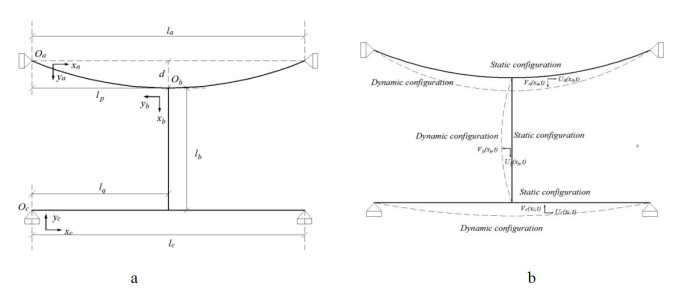

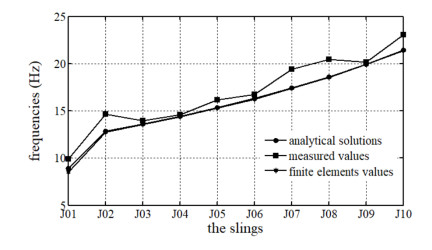
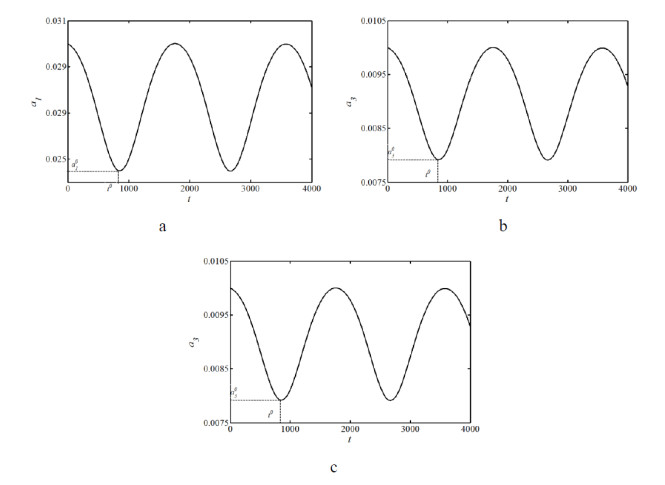
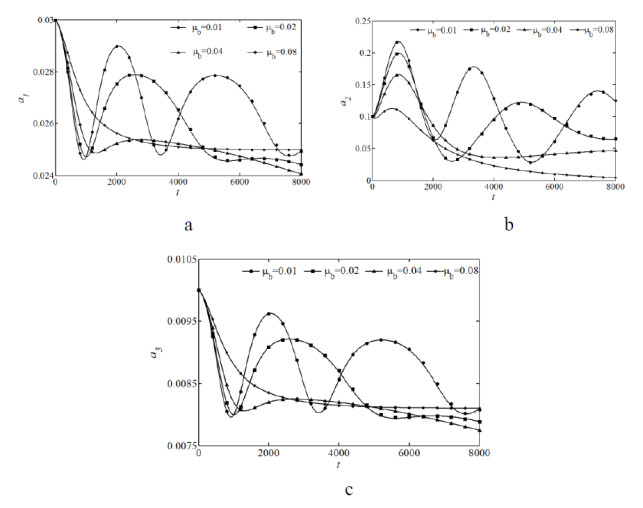
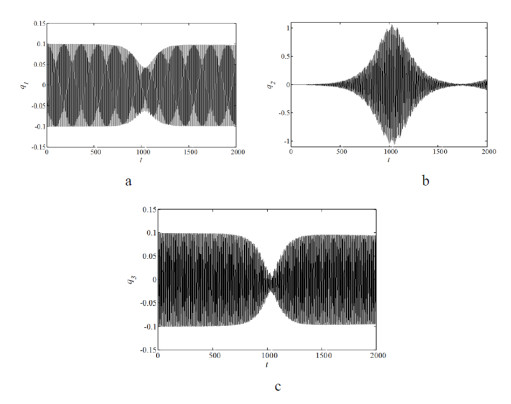
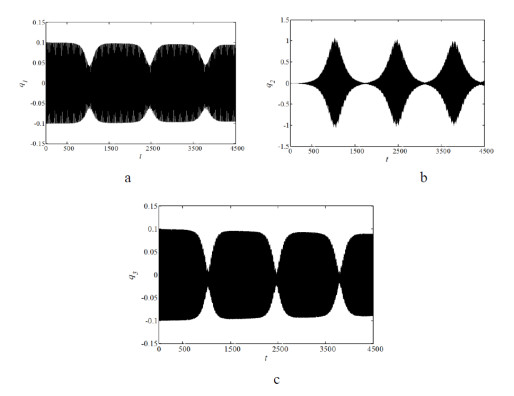
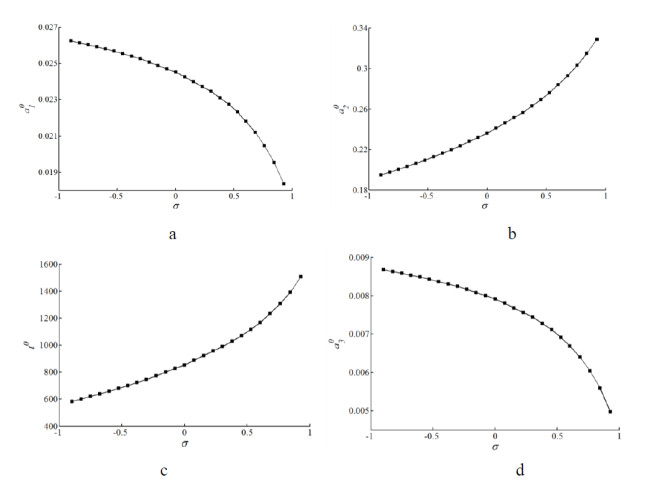
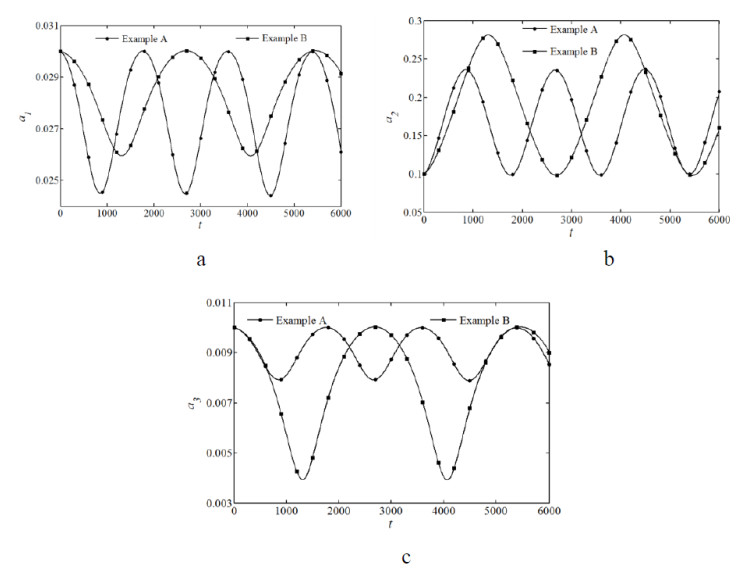
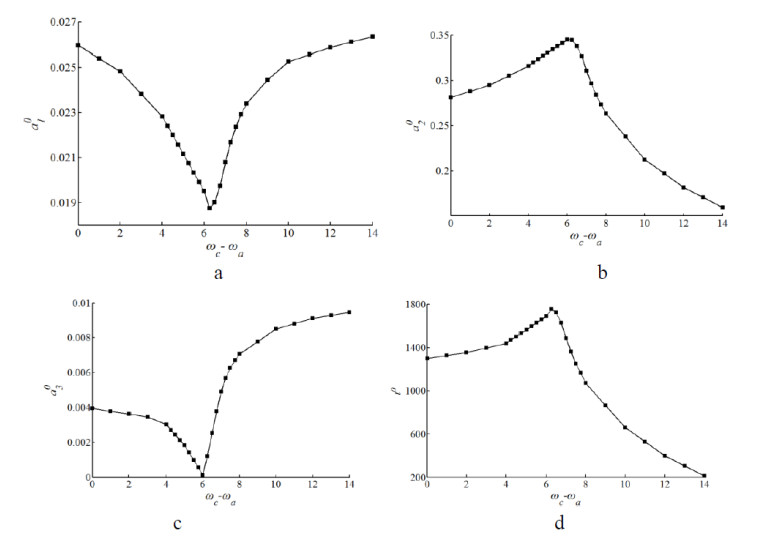


 DownLoad:
DownLoad: